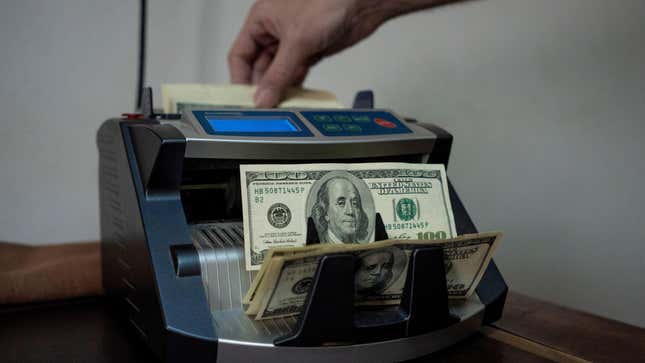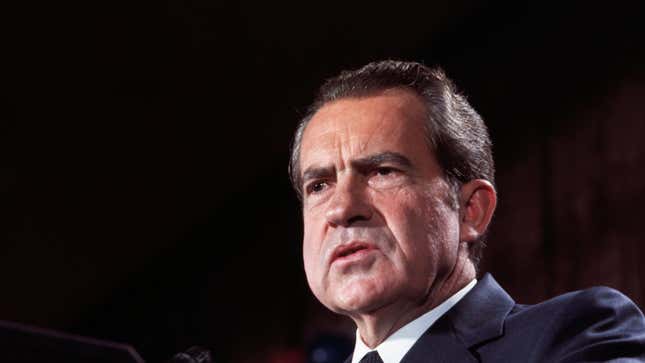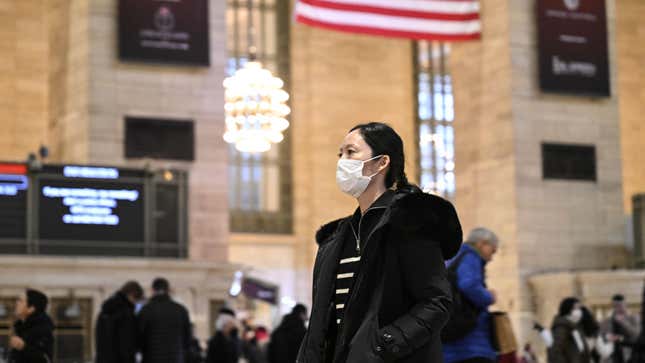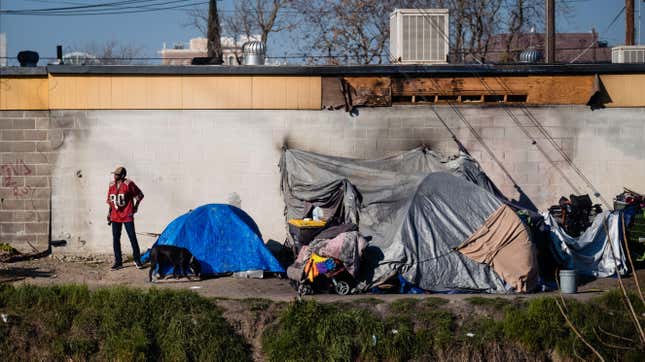Photo:
Anita
Pouchard
Serra/Bloomberg
(Getty
Images)
As
AI
becomes
a
bigger
and
bigger
part
of
our
lives,
the
threat
of
job
automation
becomes
an
increasing
possibility
for
many
people.
Lately,
there’s
been
a
lot
of
talk
about
universal
basic
income,
the
experimental
form
of
welfare
distribution
that
gives
unconditional
cash
payments
to
people
so
that
they
can
meet
their
basic
needs.
Tech
billionaires
like
Sam
Altman
say
they’re
big
fans
of
UBI
and
claim
that
it
could
solve
the
problem
of
mass
job
displacement
when
robots
and
software
take
over
much
of
our
economy.
Let’s
put
aside
Sam’s
visions
of
a
dystopian
future;
UBI
might
just
be
a
great
idea
for
our
country
to
try,
anyway.
There
have
been
many,
many
UBI
pilot
programs
over
the
past
few
decades,
and
every
time
they’re
conducted,
they
make
the
people
who
receive
payments
happier
and
healthier.
UBI
is
an
idea
with
a
long
history,
stretching
back
decades.
Let’s
take
a
quick
look
back
at
some
of
the
experiments
that
have
been
run
and
the
impact
that
they’ve
had.
Photo:
Bettmann
(Getty
Images)
Richard
Nixon
launched
a
UBI
program
in
1969
that
was
tested
on
a
small
number
of
communities.
The
program
was
designed
to
deliver
an
ongoing,
unconditional
payment
to
working
families
to
assist
them
with
their
basic
needs.
Hilariously,
one
of
the
people
put
in
charge
of
these
pilots
was
Donald
Rumsfeld,
who
was
working
in
Nixon’s
Office
of
Economic
Opportunity
at
the
time.
Rumsfeld
also
brought
on
Dick
Cheney
to
help
him
with
the
program
(later,
of
course,
the
duo
would
go
on
to
disastrously
run
Bush
II’s
White
House
foreign
policy
team
and
embroil
America
in
pointless
wars).
Fears
that
the
experiment
would
engender
laziness
in
participants
were
not
borne
out
in
the
project’s
findings:
“The
‘laziness’
contention
is
just
not
supported
by
our
findings,”
the
chief
data
analyst
of
one
of
the
experiments
said.
“There
is
not
anywhere
near
the
mass
defection
the
prophets
of
doom
predicted.”
Due
to
their
success,
Nixon’s
experiments
evolved
into
broader
plans
to
institute
a
national
UBI
that
would
have
delivered
as
much
as
$1600
a
year
to
families
of
four
(adjusted
for
inflation,
that’s
around
$10,000
per
family).
This
was
known
as
the
Family
Assistance
Plan,
or
FAP,
which
would’ve
used
something
called
a
negative
income
tax
to
fund
the
massive
new
welfare
program.
Nixon
actually
introduced
comprehensive
legislation
to
institute
the
program
but
it
was
thwarted
by
political
headwinds.
The
program
was
eventually
canceled.
Nixon’s
advisors,
including,
allegedly,
Milton
Friedman,
convinced
him
not
to
do
it.
Photo:
Bonnie
Jo
Mount/The
Washington
Post
(Getty
Images)
The
state
of
Alaska
has
one
of
the
longest-running
and
most
successful
basic
income
programs
in
the
world.
The
Alaska
Permanent
Fund
delivers
around
$1,600
a
year
to
every
resident
in
the
state
and
has
done
so
for
the
past
forty
years.
It
does
this
by
divvying
up
a
certain
percentage
of
the
proceeds
from
surplus
revenue
derived
from
one
of
Alaska’s
most
vital
resources:
its
oil
and
gas
reserves.
This
dividend,
as
it’s
called,
is
then
sent
unconditionally
to
state
residents
on
an
annual
basis.
UBI
proponents
contend
that
this
model—in
which
a
valuable
resource
is
treated
as
a
shared
economic
asset—is
one
of
the
more
promising
methods
by
which
basic
income
could
be
scaled
up
to
provide
for
a
much
larger,
national
system.
Photo:
Fatih
Aktas/Anadolu
Agency
(Getty
Images)
During
the
peak
of
the
covid-19
pandemic,
as
many
as
20
different
U.S.
cities
launched
basic
income
pilots
to
bolster
incomes
during
a
time
when
job
loss
and
economic
downturns
were
rampant.
The
programs
delivered
as
much
as
$1,000
a
month
to
recipients,
typically
for
as
long
as
a
full
year.
Data
about
the
projects
was
collected
by
the
Stanford
Basic
Income
Lab,
which
compiled
a
report
that
showed
the
pilots
had
helped
low
to
middle-income
families
meet
their
essential
needs.
Retail
purchases
comprised
about
36
percent
of
the
spending.
Meanwhile,
31
percent
of
the
proceeds
went
to
food
and
groceries,
while
housing
and
transport
received
9
percent.
The
other
spending
was
distributed
between
things
like
healthcare,
education,
and
travel.
Photo:
Al
Drago/Bloomberg
(Getty
Images)
The
Baltimore
Young
Families
Success
Fund
was
launched
in
2022
by
the
city’s
mayor
with
funding
from
the
city,
as
well
as
the
non-profit
CASH
Campaign
of
Maryland.
The
program,
which
was
designed
to
cushion
the
blow
from
covid-related
economic
turmoil,
has
consistently
delivered
$1,000
a
month
to
200
participants
and,
as
a
result,
has
invested
nearly
$5
million
in
the
community.
Survey
results
suggest
that
participants
spend
the
money
on
regular
essentials,
including
groceries,
car
payments,
and
bills.
While
not
specifically
organized
around
race,
the
experiment
targeted
mostly
young,
low-paid,
African
American
residents,
whose
income
hovered
around
$15,000
a
year.
One
21-year-old
mother
of
two,
for
instance,
said
that
she
was
able
to
afford
rent
as
a
result
of
the
cash
payment,
whereas
she
had
previously
struggled
to
make
ends
meet.
Photo:
NICK
OTTO/AFP
(Getty
Images)
The
city
of
Stockton,
California,
began
a
UBI
experiment
in
2019
that,
by
all
available
metrics,
has
been
a
big
success.
The
SEED
program,
as
it’s
called,
doled
out
monthly
unconditional
sums
of
$500
to
125
low-income
participants
for
two
years.
An
analysis
of
the
program
showed
that
it
helped
improve
the
life
experience
of
the
people
involved,
who
felt
“healthier,
showing
less
depression
and
anxiety
and
enhanced
well-being”
than
people
who
had
not
received
the
funds.
The
analysis
also
showed
that
the
extra
cash
was
primarily
used
to
pay
for
basic
needs.
Recipients
spent
the
money
mostly
on
food
(such
purchases
comprised
between
34-40
percent
of
the
money
spent),
as
well
as
retail
merchandise,
car
care,
utilities,
insurance
and
medical
expenses,
as
well
as
a
very
small
amount
of
self-care.
Stockton’s
program
is
credited
with
having
inspired
other,
similar
pilot
programs
in
other
cities—particularly
in
California.
Photo:
Ville
Mannikko/Bloomberg
(Getty
Images)
In
2017,
Finland
launched
a
program
to
give
€560
($616)
a
month
to
2,000
unemployed
citizens.
The
program,
which
lasted
two
years,
was
designed
to
replace
traditional
welfare
systems
in
Finland
that
put
employment-related
conditions
on
cash
dispersals.
Part
of
the
program’s
design
was
to
see
whether
an
unconditional
basic
income
could
net
better
rates
of
employment
in
participants
than
those
in
a
traditional
welfare
program.
While
the
program’s
results
showed
that
it
had
a
positive
emotional
impact
on
participants,
it
did
not
markedly
improve
employment
rates
for
them.
As
a
result,
some
referred
to
the
experiment
as
a
“failure.”
However,
the
experiment’s
results
also
showed
that
a
“no-strings-attached”
basic
income
did
not
markedly
dissuade
recipients
from
job-seeking
or
employment
behavior.
Instead,
it
stayed
roughly
the
same.
Photo:
David
McNew
(Getty
Images)
The
Compton
Pledge
was
a
UBI
experiment
that,
as
Time
puts
it,
sought
to
test
whether
it
could
transcend
its
“status
as
a
small
research
project
in
progressive
Los
Angeles
and
someday
work
as
a
nationwide
program
funded
by
taxpayers”.
The
Pledge
calls
itself
the
largest
UBI
experiment
in
the
U.S.
and
says
it
releases
“recurring
cash
relief
to
low-income
residents
for
2
years.”
Participants
interviewed
about
their
experience
with
the
program
have
noted
their
ability
to
pay
for
a
variety
of
things
that
would
have
been
out
of
reach
without
the
program.
Others
even
started
businesses
or
non-profit
organizations
with
the
financial
assistance
that
was
provided. The
program’s
final
report
notes:
“Residents
used
the
additional
funds
to
cover
costs
in
times
of
sickness,
start
business
ventures,
and
provide
stable
conditions
for
their
families
and
communities.”
The
program
was
funded
partially
through
private
donations.
Photo:
Gerald
Anderson/Anadolu
(Getty
Images)
The
world’s
largest
and
longest-running
UBI
experiment
was
launched
in
Kenya
in
2016
by
the
non-profit
GiveDirectly.
The
organization,
which
doles
out
unconditional
cash
transfers
to
families
living
in
extreme
poverty,
has
committed
as
much
as
$30
million
to
thousands
of
people
throughout
Africa.
The
cash
transfers
amount
to
a
lump
sum
of
$50
a
month
for
recipients—an
amount
that
can
go
quite
a
long
way
to
providing
for
basic
needs.
The
program
plans
to
continue
sending
money
to
recipients
for
as
long
as
twelve
years,
making
it
the
longest
UBI
experiment
in
existence.
A
recently
published
report
on
GiveDirectly’s
efforts
has
shown
that
this
style
of
welfare
distribution
can
be
much
more
effective
than
more
traditional
forms
of
distribution
in
alleviating
poverty.
Indeed,
initial
results
found
that
the
unconditional
cash
dispersal
did
not
“disincentivize
work”
but,
instead,
made
participants
more
economically
resilient
and
entrepreneurial.
The
full
report
on
the
experiment’s
initial
findings
concludes:
Communities
receiving
UBI
experienced
substantial
economic
expansion—more
enterprises,
higher
revenues,
costs,
and
net
revenues—and
structural
shifts,
with
the
expansion
concentrated
in
the
non-agricultural
sector.
Labor
supply
did
not
change
overall,
but
shifted
out
of
wage
employment
and
towards
self-employment.












Comments